Nursing Case Study: Patient Care, Cultural Competency, and Diagnosis
VerifiedAdded on 2020/04/21
|9
|1904
|47
Case Study
AI Summary
This nursing case study details the care of a patient admitted with per-rectal bleeding, encompassing the entire patient journey from emergency admission to discharge. The report outlines the admission process, including assessments (CT scan, blood tests, etc.), documentation, and discharge planning. It emphasizes cultural competency, considering the patient's Italian background and language needs. The case study explores the patient's independence, expectations, and social support system. It examines the admission diagnosis, medical history, and the patient's understanding of their condition, along with the involvement and impact of the Allied Health Team. Diagnostic testing and their implications are discussed, along with the importance of nursing handover, the patient's participation in care, and education provided for discharge. The case study highlights the comprehensive approach required in nursing care, addressing both medical and psychosocial aspects to ensure effective patient outcomes.

Running head: Nursing Assignment
Nursing Assignment
-Case Study in Nursing
Name of the Student
Name of the University
Author Note
Nursing Assignment
-Case Study in Nursing
Name of the Student
Name of the University
Author Note
Paraphrase This Document
Need a fresh take? Get an instant paraphrase of this document with our AI Paraphraser
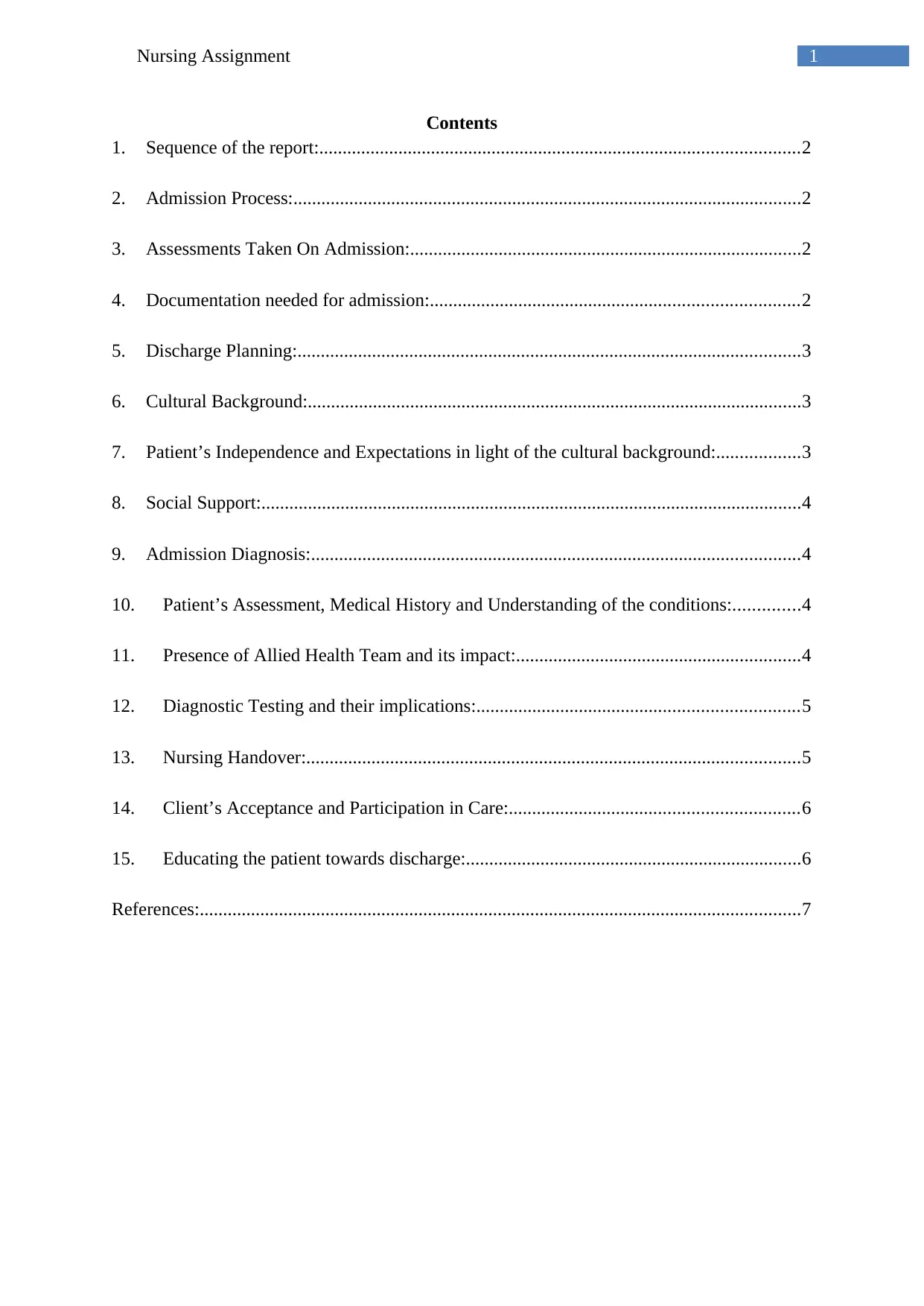
1Nursing Assignment
Contents
1. Sequence of the report:.......................................................................................................2
2. Admission Process:.............................................................................................................2
3. Assessments Taken On Admission:....................................................................................2
4. Documentation needed for admission:...............................................................................2
5. Discharge Planning:............................................................................................................3
6. Cultural Background:..........................................................................................................3
7. Patient’s Independence and Expectations in light of the cultural background:..................3
8. Social Support:....................................................................................................................4
9. Admission Diagnosis:.........................................................................................................4
10. Patient’s Assessment, Medical History and Understanding of the conditions:..............4
11. Presence of Allied Health Team and its impact:.............................................................4
12. Diagnostic Testing and their implications:.....................................................................5
13. Nursing Handover:..........................................................................................................5
14. Client’s Acceptance and Participation in Care:..............................................................6
15. Educating the patient towards discharge:........................................................................6
References:.................................................................................................................................7
Contents
1. Sequence of the report:.......................................................................................................2
2. Admission Process:.............................................................................................................2
3. Assessments Taken On Admission:....................................................................................2
4. Documentation needed for admission:...............................................................................2
5. Discharge Planning:............................................................................................................3
6. Cultural Background:..........................................................................................................3
7. Patient’s Independence and Expectations in light of the cultural background:..................3
8. Social Support:....................................................................................................................4
9. Admission Diagnosis:.........................................................................................................4
10. Patient’s Assessment, Medical History and Understanding of the conditions:..............4
11. Presence of Allied Health Team and its impact:.............................................................4
12. Diagnostic Testing and their implications:.....................................................................5
13. Nursing Handover:..........................................................................................................5
14. Client’s Acceptance and Participation in Care:..............................................................6
15. Educating the patient towards discharge:........................................................................6
References:.................................................................................................................................7
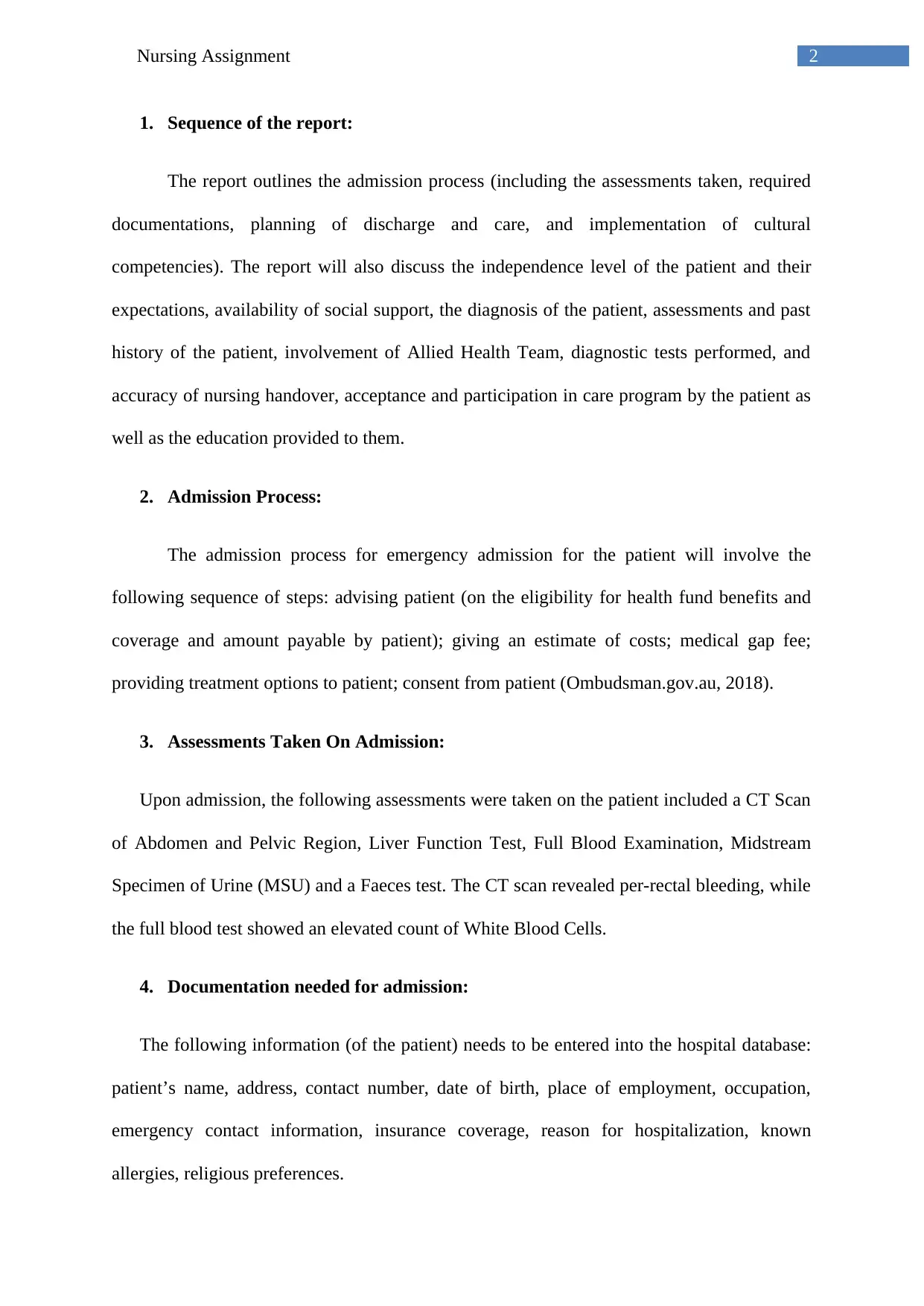
2Nursing Assignment
1. Sequence of the report:
The report outlines the admission process (including the assessments taken, required
documentations, planning of discharge and care, and implementation of cultural
competencies). The report will also discuss the independence level of the patient and their
expectations, availability of social support, the diagnosis of the patient, assessments and past
history of the patient, involvement of Allied Health Team, diagnostic tests performed, and
accuracy of nursing handover, acceptance and participation in care program by the patient as
well as the education provided to them.
2. Admission Process:
The admission process for emergency admission for the patient will involve the
following sequence of steps: advising patient (on the eligibility for health fund benefits and
coverage and amount payable by patient); giving an estimate of costs; medical gap fee;
providing treatment options to patient; consent from patient (Ombudsman.gov.au, 2018).
3. Assessments Taken On Admission:
Upon admission, the following assessments were taken on the patient included a CT Scan
of Abdomen and Pelvic Region, Liver Function Test, Full Blood Examination, Midstream
Specimen of Urine (MSU) and a Faeces test. The CT scan revealed per-rectal bleeding, while
the full blood test showed an elevated count of White Blood Cells.
4. Documentation needed for admission:
The following information (of the patient) needs to be entered into the hospital database:
patient’s name, address, contact number, date of birth, place of employment, occupation,
emergency contact information, insurance coverage, reason for hospitalization, known
allergies, religious preferences.
1. Sequence of the report:
The report outlines the admission process (including the assessments taken, required
documentations, planning of discharge and care, and implementation of cultural
competencies). The report will also discuss the independence level of the patient and their
expectations, availability of social support, the diagnosis of the patient, assessments and past
history of the patient, involvement of Allied Health Team, diagnostic tests performed, and
accuracy of nursing handover, acceptance and participation in care program by the patient as
well as the education provided to them.
2. Admission Process:
The admission process for emergency admission for the patient will involve the
following sequence of steps: advising patient (on the eligibility for health fund benefits and
coverage and amount payable by patient); giving an estimate of costs; medical gap fee;
providing treatment options to patient; consent from patient (Ombudsman.gov.au, 2018).
3. Assessments Taken On Admission:
Upon admission, the following assessments were taken on the patient included a CT Scan
of Abdomen and Pelvic Region, Liver Function Test, Full Blood Examination, Midstream
Specimen of Urine (MSU) and a Faeces test. The CT scan revealed per-rectal bleeding, while
the full blood test showed an elevated count of White Blood Cells.
4. Documentation needed for admission:
The following information (of the patient) needs to be entered into the hospital database:
patient’s name, address, contact number, date of birth, place of employment, occupation,
emergency contact information, insurance coverage, reason for hospitalization, known
allergies, religious preferences.
⊘ This is a preview!⊘
Do you want full access?
Subscribe today to unlock all pages.

Trusted by 1+ million students worldwide
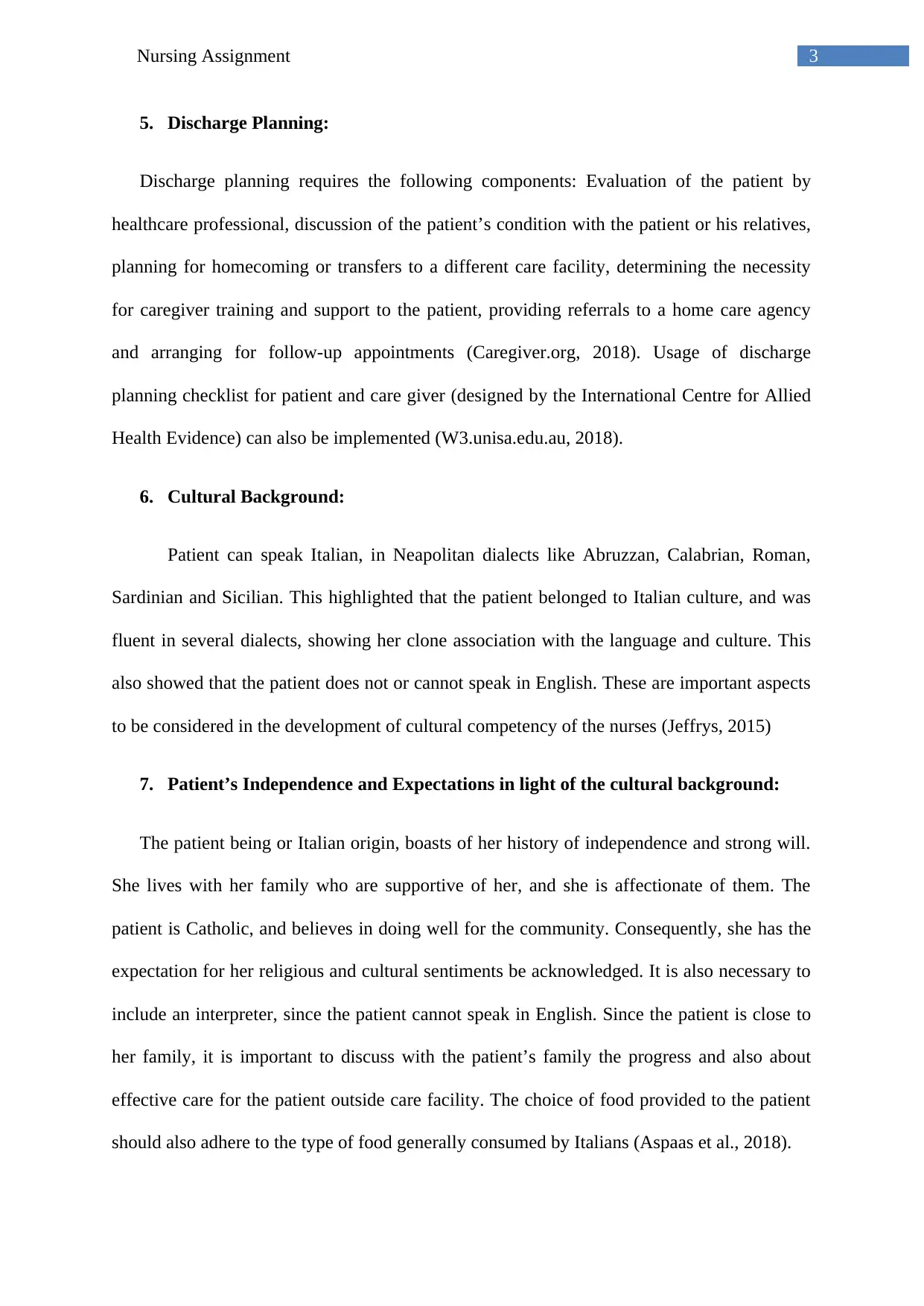
3Nursing Assignment
5. Discharge Planning:
Discharge planning requires the following components: Evaluation of the patient by
healthcare professional, discussion of the patient’s condition with the patient or his relatives,
planning for homecoming or transfers to a different care facility, determining the necessity
for caregiver training and support to the patient, providing referrals to a home care agency
and arranging for follow-up appointments (Caregiver.org, 2018). Usage of discharge
planning checklist for patient and care giver (designed by the International Centre for Allied
Health Evidence) can also be implemented (W3.unisa.edu.au, 2018).
6. Cultural Background:
Patient can speak Italian, in Neapolitan dialects like Abruzzan, Calabrian, Roman,
Sardinian and Sicilian. This highlighted that the patient belonged to Italian culture, and was
fluent in several dialects, showing her clone association with the language and culture. This
also showed that the patient does not or cannot speak in English. These are important aspects
to be considered in the development of cultural competency of the nurses (Jeffrys, 2015)
7. Patient’s Independence and Expectations in light of the cultural background:
The patient being or Italian origin, boasts of her history of independence and strong will.
She lives with her family who are supportive of her, and she is affectionate of them. The
patient is Catholic, and believes in doing well for the community. Consequently, she has the
expectation for her religious and cultural sentiments be acknowledged. It is also necessary to
include an interpreter, since the patient cannot speak in English. Since the patient is close to
her family, it is important to discuss with the patient’s family the progress and also about
effective care for the patient outside care facility. The choice of food provided to the patient
should also adhere to the type of food generally consumed by Italians (Aspaas et al., 2018).
5. Discharge Planning:
Discharge planning requires the following components: Evaluation of the patient by
healthcare professional, discussion of the patient’s condition with the patient or his relatives,
planning for homecoming or transfers to a different care facility, determining the necessity
for caregiver training and support to the patient, providing referrals to a home care agency
and arranging for follow-up appointments (Caregiver.org, 2018). Usage of discharge
planning checklist for patient and care giver (designed by the International Centre for Allied
Health Evidence) can also be implemented (W3.unisa.edu.au, 2018).
6. Cultural Background:
Patient can speak Italian, in Neapolitan dialects like Abruzzan, Calabrian, Roman,
Sardinian and Sicilian. This highlighted that the patient belonged to Italian culture, and was
fluent in several dialects, showing her clone association with the language and culture. This
also showed that the patient does not or cannot speak in English. These are important aspects
to be considered in the development of cultural competency of the nurses (Jeffrys, 2015)
7. Patient’s Independence and Expectations in light of the cultural background:
The patient being or Italian origin, boasts of her history of independence and strong will.
She lives with her family who are supportive of her, and she is affectionate of them. The
patient is Catholic, and believes in doing well for the community. Consequently, she has the
expectation for her religious and cultural sentiments be acknowledged. It is also necessary to
include an interpreter, since the patient cannot speak in English. Since the patient is close to
her family, it is important to discuss with the patient’s family the progress and also about
effective care for the patient outside care facility. The choice of food provided to the patient
should also adhere to the type of food generally consumed by Italians (Aspaas et al., 2018).
Paraphrase This Document
Need a fresh take? Get an instant paraphrase of this document with our AI Paraphraser
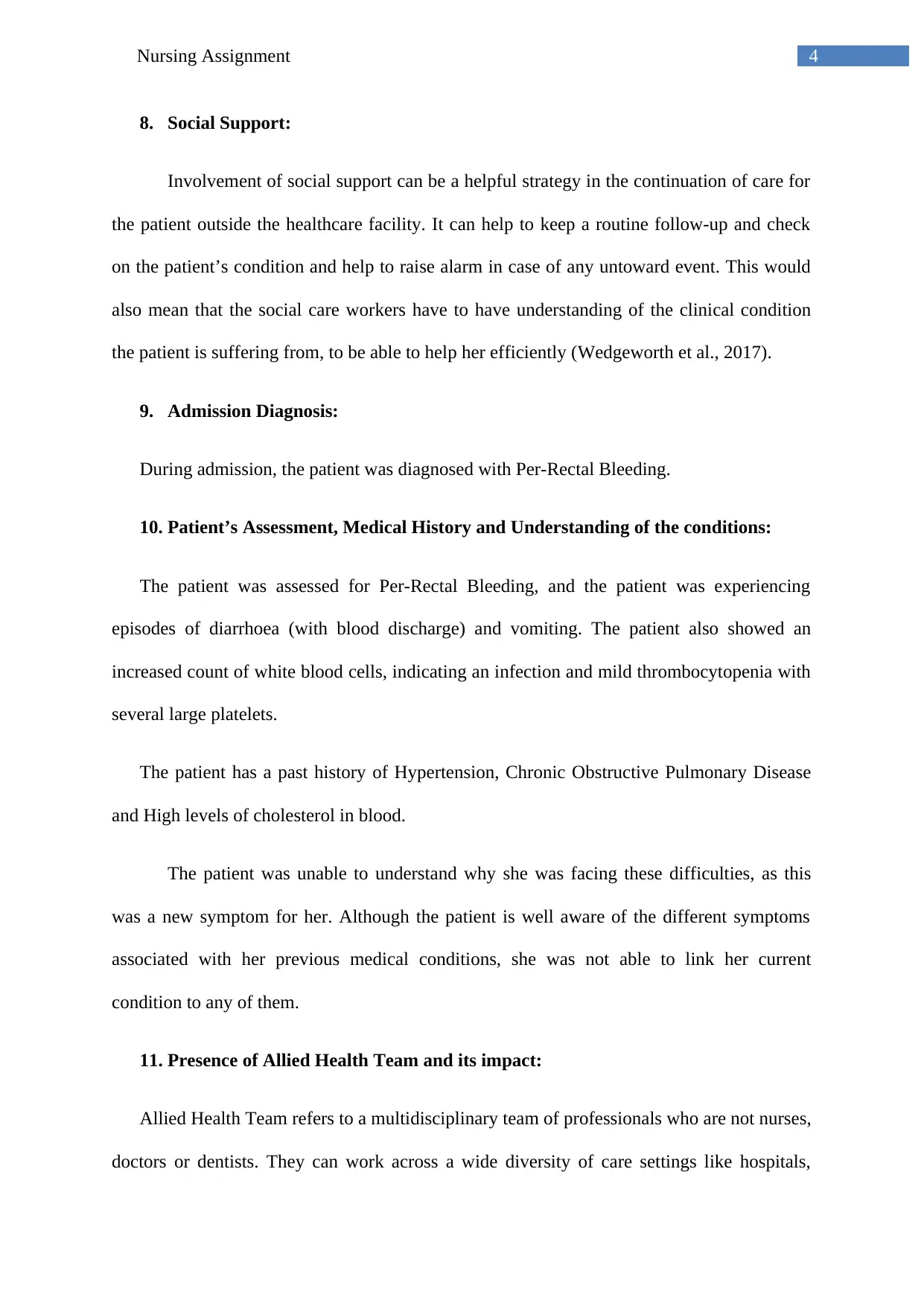
4Nursing Assignment
8. Social Support:
Involvement of social support can be a helpful strategy in the continuation of care for
the patient outside the healthcare facility. It can help to keep a routine follow-up and check
on the patient’s condition and help to raise alarm in case of any untoward event. This would
also mean that the social care workers have to have understanding of the clinical condition
the patient is suffering from, to be able to help her efficiently (Wedgeworth et al., 2017).
9. Admission Diagnosis:
During admission, the patient was diagnosed with Per-Rectal Bleeding.
10. Patient’s Assessment, Medical History and Understanding of the conditions:
The patient was assessed for Per-Rectal Bleeding, and the patient was experiencing
episodes of diarrhoea (with blood discharge) and vomiting. The patient also showed an
increased count of white blood cells, indicating an infection and mild thrombocytopenia with
several large platelets.
The patient has a past history of Hypertension, Chronic Obstructive Pulmonary Disease
and High levels of cholesterol in blood.
The patient was unable to understand why she was facing these difficulties, as this
was a new symptom for her. Although the patient is well aware of the different symptoms
associated with her previous medical conditions, she was not able to link her current
condition to any of them.
11. Presence of Allied Health Team and its impact:
Allied Health Team refers to a multidisciplinary team of professionals who are not nurses,
doctors or dentists. They can work across a wide diversity of care settings like hospitals,
8. Social Support:
Involvement of social support can be a helpful strategy in the continuation of care for
the patient outside the healthcare facility. It can help to keep a routine follow-up and check
on the patient’s condition and help to raise alarm in case of any untoward event. This would
also mean that the social care workers have to have understanding of the clinical condition
the patient is suffering from, to be able to help her efficiently (Wedgeworth et al., 2017).
9. Admission Diagnosis:
During admission, the patient was diagnosed with Per-Rectal Bleeding.
10. Patient’s Assessment, Medical History and Understanding of the conditions:
The patient was assessed for Per-Rectal Bleeding, and the patient was experiencing
episodes of diarrhoea (with blood discharge) and vomiting. The patient also showed an
increased count of white blood cells, indicating an infection and mild thrombocytopenia with
several large platelets.
The patient has a past history of Hypertension, Chronic Obstructive Pulmonary Disease
and High levels of cholesterol in blood.
The patient was unable to understand why she was facing these difficulties, as this
was a new symptom for her. Although the patient is well aware of the different symptoms
associated with her previous medical conditions, she was not able to link her current
condition to any of them.
11. Presence of Allied Health Team and its impact:
Allied Health Team refers to a multidisciplinary team of professionals who are not nurses,
doctors or dentists. They can work across a wide diversity of care settings like hospitals,
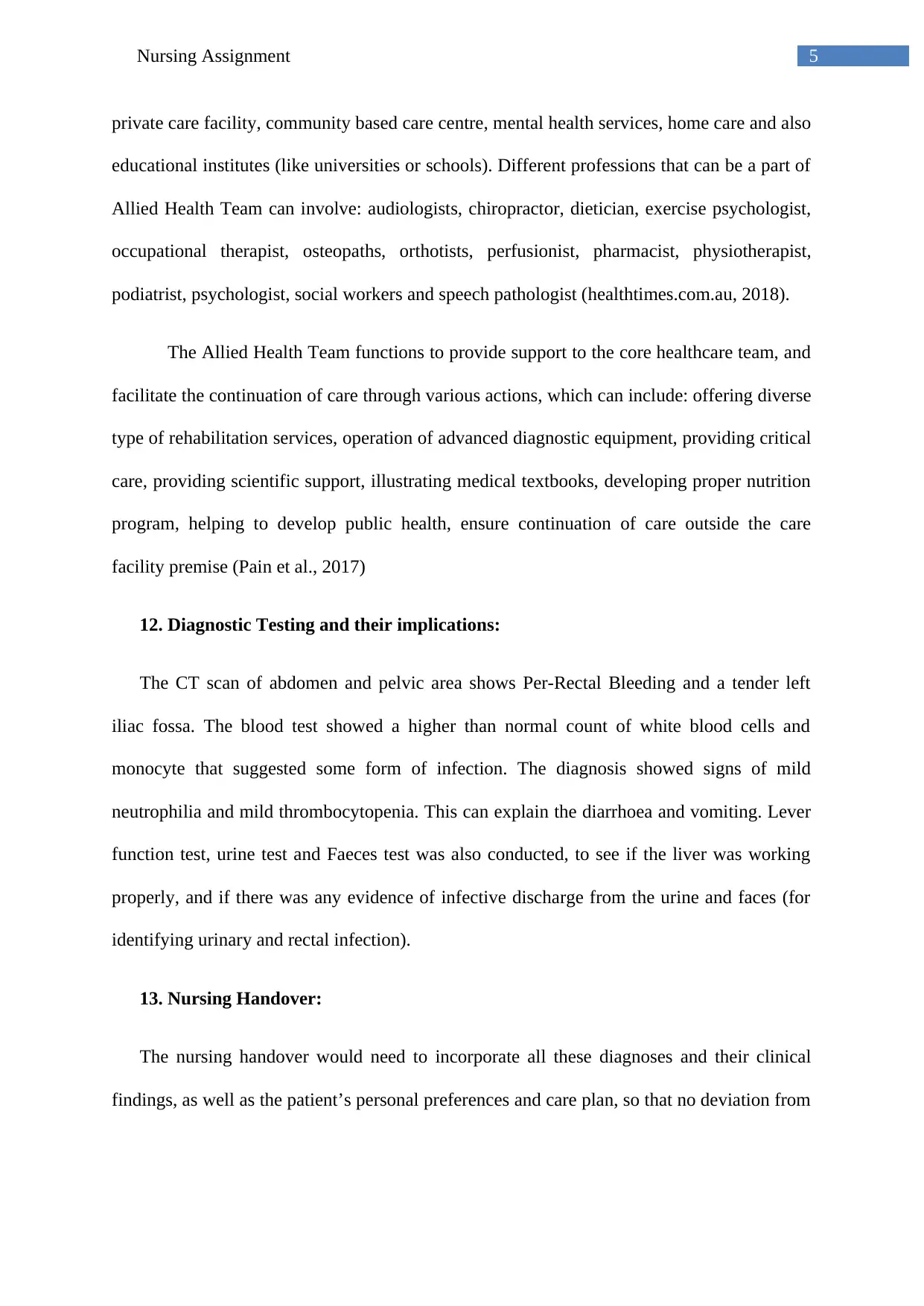
5Nursing Assignment
private care facility, community based care centre, mental health services, home care and also
educational institutes (like universities or schools). Different professions that can be a part of
Allied Health Team can involve: audiologists, chiropractor, dietician, exercise psychologist,
occupational therapist, osteopaths, orthotists, perfusionist, pharmacist, physiotherapist,
podiatrist, psychologist, social workers and speech pathologist (healthtimes.com.au, 2018).
The Allied Health Team functions to provide support to the core healthcare team, and
facilitate the continuation of care through various actions, which can include: offering diverse
type of rehabilitation services, operation of advanced diagnostic equipment, providing critical
care, providing scientific support, illustrating medical textbooks, developing proper nutrition
program, helping to develop public health, ensure continuation of care outside the care
facility premise (Pain et al., 2017)
12. Diagnostic Testing and their implications:
The CT scan of abdomen and pelvic area shows Per-Rectal Bleeding and a tender left
iliac fossa. The blood test showed a higher than normal count of white blood cells and
monocyte that suggested some form of infection. The diagnosis showed signs of mild
neutrophilia and mild thrombocytopenia. This can explain the diarrhoea and vomiting. Lever
function test, urine test and Faeces test was also conducted, to see if the liver was working
properly, and if there was any evidence of infective discharge from the urine and faces (for
identifying urinary and rectal infection).
13. Nursing Handover:
The nursing handover would need to incorporate all these diagnoses and their clinical
findings, as well as the patient’s personal preferences and care plan, so that no deviation from
private care facility, community based care centre, mental health services, home care and also
educational institutes (like universities or schools). Different professions that can be a part of
Allied Health Team can involve: audiologists, chiropractor, dietician, exercise psychologist,
occupational therapist, osteopaths, orthotists, perfusionist, pharmacist, physiotherapist,
podiatrist, psychologist, social workers and speech pathologist (healthtimes.com.au, 2018).
The Allied Health Team functions to provide support to the core healthcare team, and
facilitate the continuation of care through various actions, which can include: offering diverse
type of rehabilitation services, operation of advanced diagnostic equipment, providing critical
care, providing scientific support, illustrating medical textbooks, developing proper nutrition
program, helping to develop public health, ensure continuation of care outside the care
facility premise (Pain et al., 2017)
12. Diagnostic Testing and their implications:
The CT scan of abdomen and pelvic area shows Per-Rectal Bleeding and a tender left
iliac fossa. The blood test showed a higher than normal count of white blood cells and
monocyte that suggested some form of infection. The diagnosis showed signs of mild
neutrophilia and mild thrombocytopenia. This can explain the diarrhoea and vomiting. Lever
function test, urine test and Faeces test was also conducted, to see if the liver was working
properly, and if there was any evidence of infective discharge from the urine and faces (for
identifying urinary and rectal infection).
13. Nursing Handover:
The nursing handover would need to incorporate all these diagnoses and their clinical
findings, as well as the patient’s personal preferences and care plan, so that no deviation from
⊘ This is a preview!⊘
Do you want full access?
Subscribe today to unlock all pages.

Trusted by 1+ million students worldwide

6Nursing Assignment
the plan occurs, and the next nurse is able to fully understand that progression of the
treatment, and the care requirements of the patient (Sabet Sarvestani et al., 2015).
14. Client’s Acceptance and Participation in Care:
The client was able to understand the importance of the diagnostic tests and treatment
plan used. She was acceptable towards the continuation of care, however preferred that her
care be continued in her home, as she preferred not to stay away from her family for long
periods of time. Additionally, the presence of the patient’s family was a major mental support
for the patient.
15. Educating the patient towards discharge:
The patient as well as her care givers needs to be completely briefed regarding the
post discharge care for the patient, including the administration of medicines, identification of
any complications and its reporting, and setting up patient’s expectations of what might
happen after discharge. Other information like the diet to be followed, and point for contact
should also be available for both the patient and their families.
the plan occurs, and the next nurse is able to fully understand that progression of the
treatment, and the care requirements of the patient (Sabet Sarvestani et al., 2015).
14. Client’s Acceptance and Participation in Care:
The client was able to understand the importance of the diagnostic tests and treatment
plan used. She was acceptable towards the continuation of care, however preferred that her
care be continued in her home, as she preferred not to stay away from her family for long
periods of time. Additionally, the presence of the patient’s family was a major mental support
for the patient.
15. Educating the patient towards discharge:
The patient as well as her care givers needs to be completely briefed regarding the
post discharge care for the patient, including the administration of medicines, identification of
any complications and its reporting, and setting up patient’s expectations of what might
happen after discharge. Other information like the diet to be followed, and point for contact
should also be available for both the patient and their families.
Paraphrase This Document
Need a fresh take? Get an instant paraphrase of this document with our AI Paraphraser
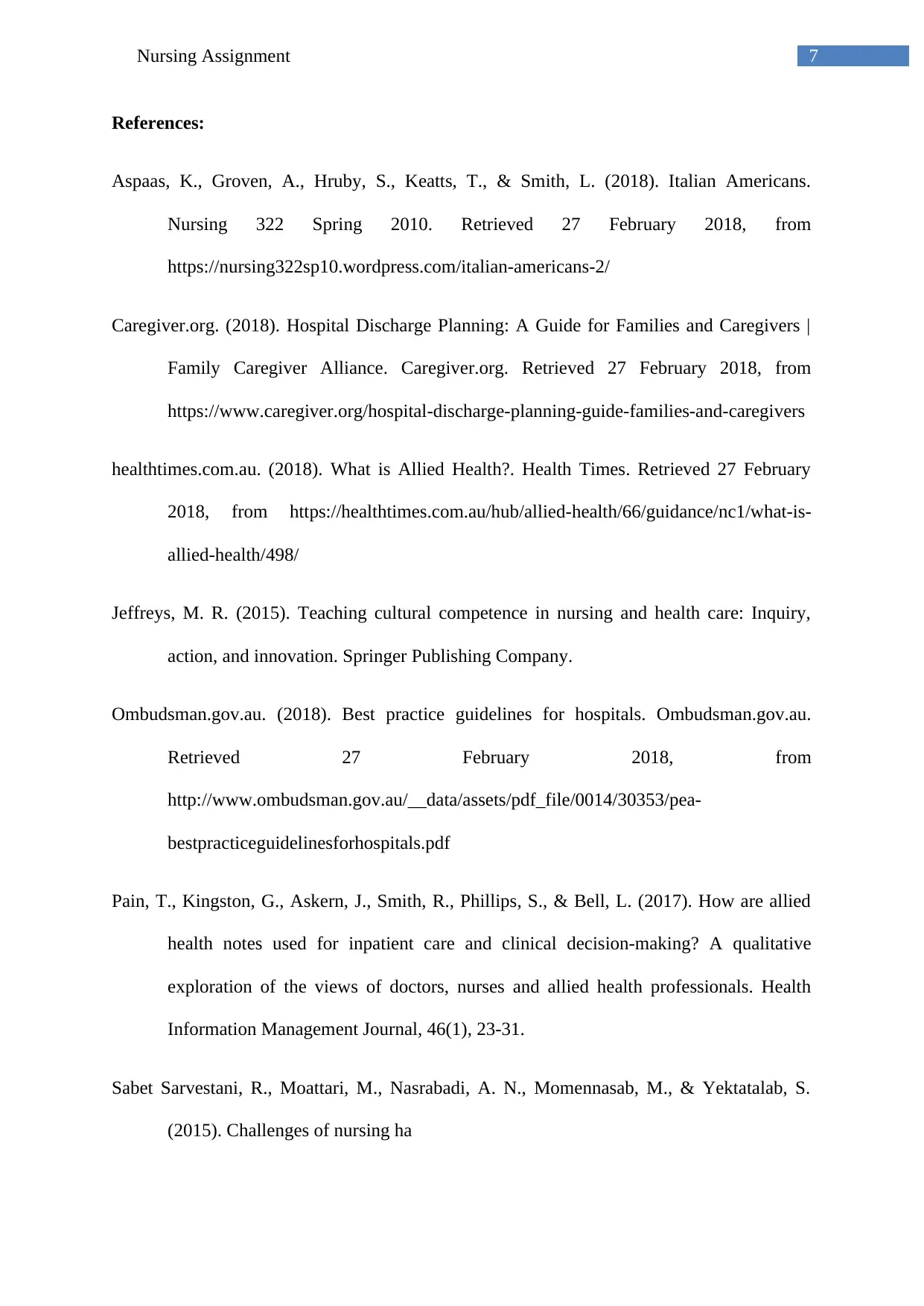
7Nursing Assignment
References:
Aspaas, K., Groven, A., Hruby, S., Keatts, T., & Smith, L. (2018). Italian Americans.
Nursing 322 Spring 2010. Retrieved 27 February 2018, from
https://nursing322sp10.wordpress.com/italian-americans-2/
Caregiver.org. (2018). Hospital Discharge Planning: A Guide for Families and Caregivers |
Family Caregiver Alliance. Caregiver.org. Retrieved 27 February 2018, from
https://www.caregiver.org/hospital-discharge-planning-guide-families-and-caregivers
healthtimes.com.au. (2018). What is Allied Health?. Health Times. Retrieved 27 February
2018, from https://healthtimes.com.au/hub/allied-health/66/guidance/nc1/what-is-
allied-health/498/
Jeffreys, M. R. (2015). Teaching cultural competence in nursing and health care: Inquiry,
action, and innovation. Springer Publishing Company.
Ombudsman.gov.au. (2018). Best practice guidelines for hospitals. Ombudsman.gov.au.
Retrieved 27 February 2018, from
http://www.ombudsman.gov.au/__data/assets/pdf_file/0014/30353/pea-
bestpracticeguidelinesforhospitals.pdf
Pain, T., Kingston, G., Askern, J., Smith, R., Phillips, S., & Bell, L. (2017). How are allied
health notes used for inpatient care and clinical decision-making? A qualitative
exploration of the views of doctors, nurses and allied health professionals. Health
Information Management Journal, 46(1), 23-31.
Sabet Sarvestani, R., Moattari, M., Nasrabadi, A. N., Momennasab, M., & Yektatalab, S.
(2015). Challenges of nursing ha
References:
Aspaas, K., Groven, A., Hruby, S., Keatts, T., & Smith, L. (2018). Italian Americans.
Nursing 322 Spring 2010. Retrieved 27 February 2018, from
https://nursing322sp10.wordpress.com/italian-americans-2/
Caregiver.org. (2018). Hospital Discharge Planning: A Guide for Families and Caregivers |
Family Caregiver Alliance. Caregiver.org. Retrieved 27 February 2018, from
https://www.caregiver.org/hospital-discharge-planning-guide-families-and-caregivers
healthtimes.com.au. (2018). What is Allied Health?. Health Times. Retrieved 27 February
2018, from https://healthtimes.com.au/hub/allied-health/66/guidance/nc1/what-is-
allied-health/498/
Jeffreys, M. R. (2015). Teaching cultural competence in nursing and health care: Inquiry,
action, and innovation. Springer Publishing Company.
Ombudsman.gov.au. (2018). Best practice guidelines for hospitals. Ombudsman.gov.au.
Retrieved 27 February 2018, from
http://www.ombudsman.gov.au/__data/assets/pdf_file/0014/30353/pea-
bestpracticeguidelinesforhospitals.pdf
Pain, T., Kingston, G., Askern, J., Smith, R., Phillips, S., & Bell, L. (2017). How are allied
health notes used for inpatient care and clinical decision-making? A qualitative
exploration of the views of doctors, nurses and allied health professionals. Health
Information Management Journal, 46(1), 23-31.
Sabet Sarvestani, R., Moattari, M., Nasrabadi, A. N., Momennasab, M., & Yektatalab, S.
(2015). Challenges of nursing ha
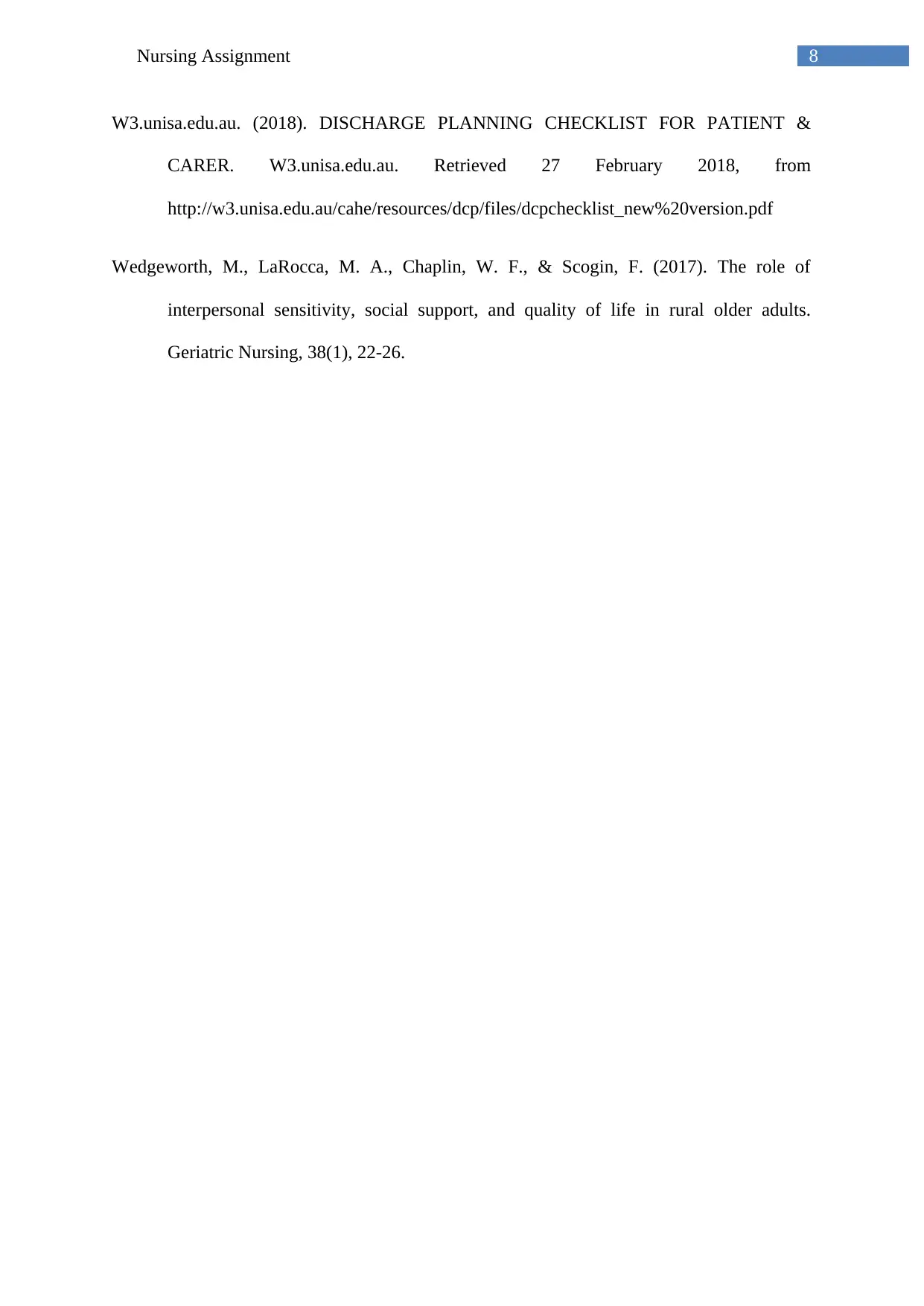
8Nursing Assignment
W3.unisa.edu.au. (2018). DISCHARGE PLANNING CHECKLIST FOR PATIENT &
CARER. W3.unisa.edu.au. Retrieved 27 February 2018, from
http://w3.unisa.edu.au/cahe/resources/dcp/files/dcpchecklist_new%20version.pdf
Wedgeworth, M., LaRocca, M. A., Chaplin, W. F., & Scogin, F. (2017). The role of
interpersonal sensitivity, social support, and quality of life in rural older adults.
Geriatric Nursing, 38(1), 22-26.
W3.unisa.edu.au. (2018). DISCHARGE PLANNING CHECKLIST FOR PATIENT &
CARER. W3.unisa.edu.au. Retrieved 27 February 2018, from
http://w3.unisa.edu.au/cahe/resources/dcp/files/dcpchecklist_new%20version.pdf
Wedgeworth, M., LaRocca, M. A., Chaplin, W. F., & Scogin, F. (2017). The role of
interpersonal sensitivity, social support, and quality of life in rural older adults.
Geriatric Nursing, 38(1), 22-26.
⊘ This is a preview!⊘
Do you want full access?
Subscribe today to unlock all pages.

Trusted by 1+ million students worldwide
1 out of 9
Related Documents
Your All-in-One AI-Powered Toolkit for Academic Success.
+13062052269
info@desklib.com
Available 24*7 on WhatsApp / Email
![[object Object]](/_next/static/media/star-bottom.7253800d.svg)
Unlock your academic potential
Copyright © 2020–2025 A2Z Services. All Rights Reserved. Developed and managed by ZUCOL.





